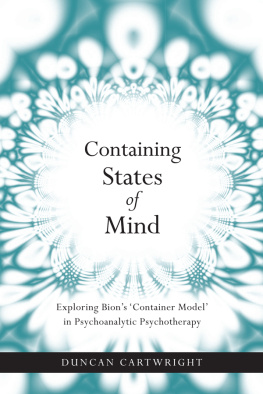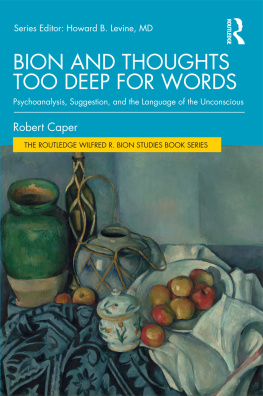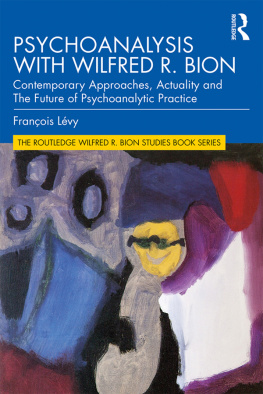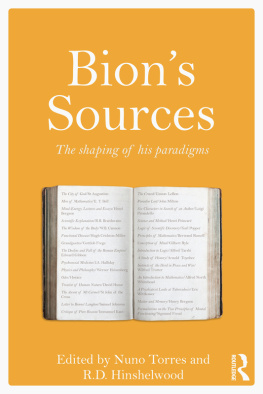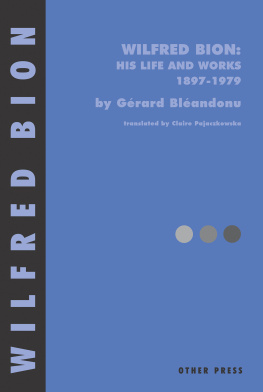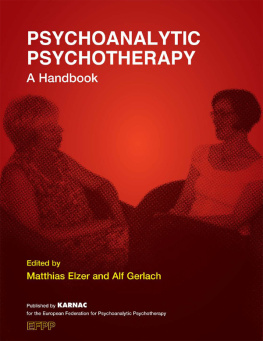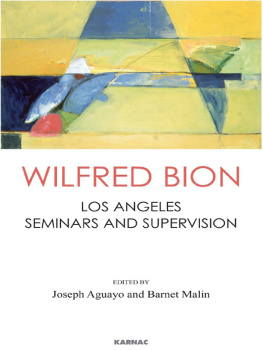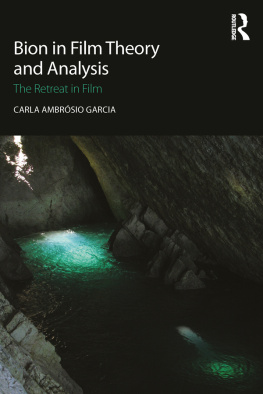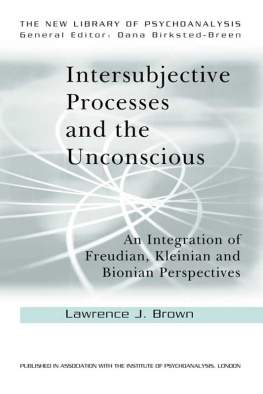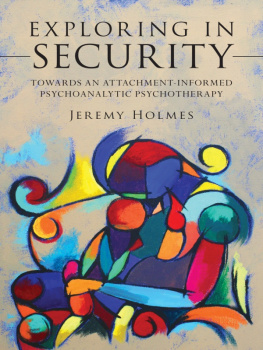Containing States of Mind
Exploring Bions Container Model in
Psychoanalytic Psychotherapy
Duncan Cartwright
First published 2010 by Routledge
Published 2013 by Routledge
2 Park Square, Milton Park, Abingdon, Oxon 0X14 4RN
711 Third Avenue, New York, NY 10017, USA
Routledge is an imprint of the Taylor & Francis Group, an Informa business
Copyright 2010 Duncan Cartwright
Typeset in Times by Garfield Morgan, Swansea, West Glamorgan Paperback cover design by Lisa Dynan
All rights reserved. No part of this book may be reprinted or reproduced or utilised in any form or by any electronic, mechanical, or other means, now known or hereafter invented, including photocopying and recording, or in any information storage or retrieval system, without permission in writing from the publishers.
British Library Cataloguing in Publication Data
A catalogue record for this book is available from the British Library
Library of Congress Cataloging-in-Publication Data
Cartwright, Duncan, 1968
Containing states of mind : exploring Bions container model in
psychoanalytic psychotherapy / Duncan Cartwright.
p. cm.
Includes bibliographical references.
ISBN 978-1-58391-878-4 (hardback) ISBN 978-1-58391-879-1 (pbk.)
1. Psychoanalysis. 2. Psychodynamic psychotherapy. 3. Bion, Wilfred R.
(Wilfred Ruprecht), 18971979. I. Title.
RC480.5.C365 2009
616.8917-dc22
2009006828
ISBN: 978-1-58391-878-4 (hbk)
ISBN 978-1-583-91879-1 (pbk)
Contents
References
Wilfred Bions ideas about psychoanalysis and psychotherapy continue to enrich our thinking about how we should approach analytic encounters. In this book I explore and develop his model of the container and related ideas. Bions ideas about the container stand out as a major contribution to understanding the invariants of analytic experience and the transformatory conditions for generating psychic meaning and change. Grotstein (1979) goes so far as to say that the container-contained configuration uncovers a new natural law (p. 110), a new way of organizing material that exposes new ways of seeing the order of things. However, despite the usefulness and popularity of the idea of containing in various forms of psychoanalytic practice, understanding and application of the container model varies greatly and still remains relatively under-theorized. The focus of this volume is twofold: first, I explore various theoretical aspects of the container model putting forward ideas about how I apply it in the therapeutic setting; second, I explore and develop some implications that the model has for understanding the development of pathological states or ways of thinking.
Developing Melanie Kleins (1946) ideas about projective identification, Bion thought that projective identifications, split-off parts of the self that are located in other objects, required containment in another mind if they were to be modified in some way. His thinking introduces a particular dynamic that he based on the prototype of a sexual union denoted by (container-contained).
Bions container model can be applied in various ways at different levels of abstraction. In the clinical setting it translates into a model whereby the analytic pair (predominantly the analyst) attempt to make unbearable mental states more bearable, in turn, enriching the scope of the experiential field. Because unbearable mental states remain separated, split off, from the patients core self, the therapists containing function relies on attending to thoughts and feelings at the periphery of his awareness. For this reason the therapists reverie, his dream thoughts, become a gateway to accessing unprocessed experience that requires further psychic work. In this way the therapists container function becomes part of broader psychic processing system, picking up on and attending to parts of the patients internal world that for various reasons cannot be tolerated or given meaning. There are many questions here:
How does one apply Bions container-contained configuration to the clinical setting?
What is the difference between the container function and the container-contained configuration?
How does the analyst make use of his reverie in this process?
What implications does the container have for understanding pathological processes?
It could be said that Freud chartered a metapsychology that had as its driving force the energetics of the unconscious pitted against reality. Klein, on the other hand, sought to understand the concrete nature of internal objects, phantasy, and their management through projective and introjective processes. Bions point of entry is quite different. It lies at the interface between objects and thinking, between individuals' minds, in search of transformative links that make change possible. In this way, Bion brought to psychoanalysis a unique perspective on what might be called the psychoanalysis of encounter. Although his work underwent a number of transformations it is the encounter between minds, and how this generates change, that remains a constant fascination to Bion. He emphasizes, particularly in his later work, the idea that the mind is always in transit and is constantly in a state of becoming something else. External reality is not thought of as being a stable, consistent, objective entity, suitable for Cartesian apprehension. Rather, it is always mediated through the mind of an other. From this perspective we are left with a difficult set of parameters to work with: a mind is dependent on another mind for meaning but this necessarily remains ineffable, opaque, and always in flux.
Perhaps along with Winnicott, Bion was a true innovator of the in between. Rather than getting mired in theoretical dilemmas about the role of affect, sexuality, the drives and so forth, much of his thinking focused on understanding how the encounter between subjectivities is able to transform psychic occurrences (bearing influences from internal and external experience) into meaningful experience, in turn, leading to growth of the personality. In many ways Bions thinking can be seen to pre-empt some of the current debates on intersubjectivity in psychoanalysis (e.g. Beebe et al., 2005; Benjamin, 1990; 1998; Gentile, 2007; Mitchell, 2000; Stolorow et al., 2002).
Unlike much of the thinking about intersubjectivity, however, which tends to emphasize a harmonious mutuality between patient and client, Bions ideas attempt to articulate the struggle we are engaged in when we are truly engaged with an other. For Bion, a real human mental connection is like an emotional storm caused by the coming together of minds that crave and resist each other. Although we are equipped with some kind of primary awareness of sensory objects and emotions, the ability to think and generate meaning demands that the encounter be subjected to a series of transformations that Bion made central to his work. The task becomes finding ways of tolerating this emotional storm for long enough so that it can be thought about and given particular personal meaning. As put by Bion, it involves working out how to make the best of a bad job (1987, p.247). It is here that he locates the model of the container.
Despite Bions often abstruse use of abstract terms and complex theoretical notions, it seems to me that the essence of his contribution lies in his struggle to articulate the transformatory qualities of

